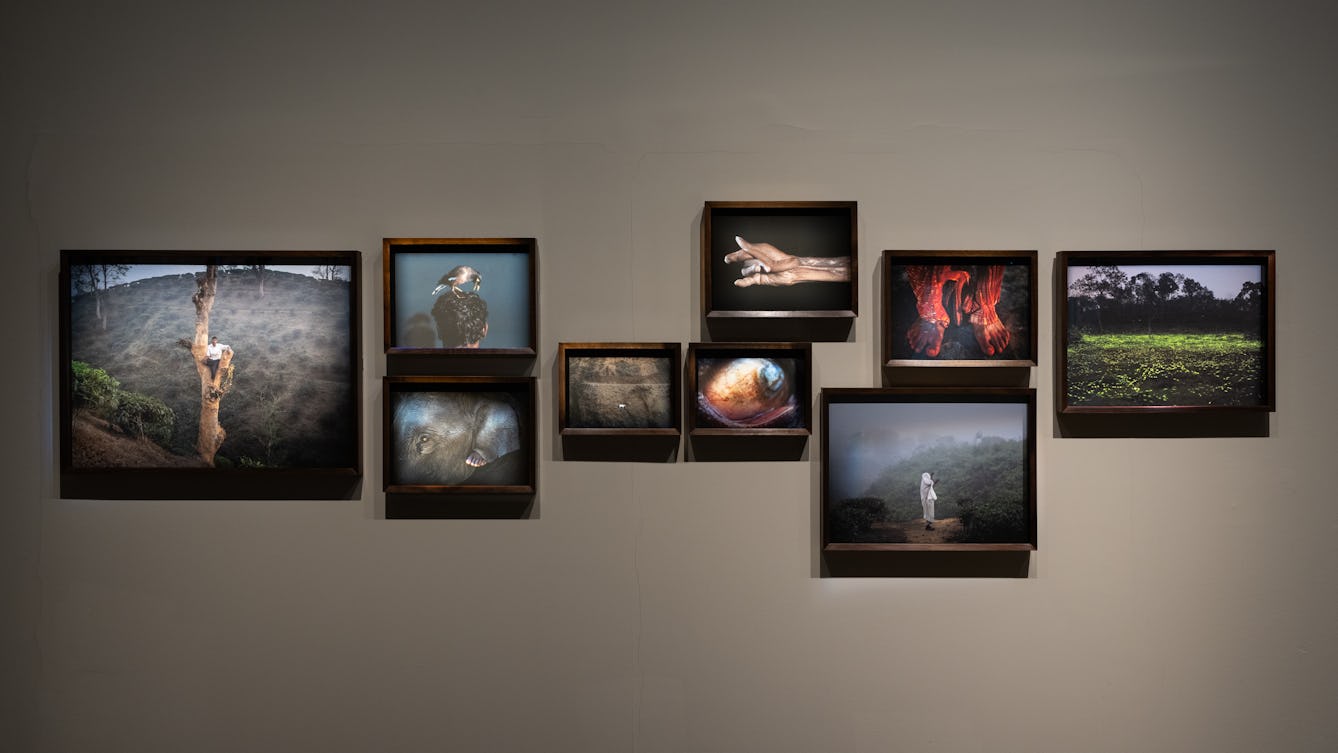When facing this work, there is a yellow bench behind you.
Hello, I am Cindy Sissokho, the curator of the exhibition again.
‘Dark Garden’ is an ongoing photographic series by artist Muhammad Fazla Rabbi Fatiq, documenting the lives of workers on tea plantations in the Sylhet region, in the northeast of Bangladesh.
The photographs document the traces of plantation work on the workers’ bodies, as well as their precious moments of rest, prayer and softness, for example through their relationships with animals.
Spread across the wall are nine colour landscape photographs ranging from A2 to A5, in dark brown wooden frames. Three of these will be described.
The largest photograph, on the far left, is of a hilly plantation bisected by a towering, bare tree. A young man of South Asian heritage looks out at us from his perch in a fork of the tree, the right side of his body pressing into the sandy-coloured trunk, his left arm resting atop a protruding branch stump. He wears a dusty white shirt and worn dark trousers, sleeves and hems rolled up. Underneath a crop of black hair, his face is relaxed in this moment away from work. The tree stands on a parched slope, surrounded by tea bushes and dry, prickly grass. In the hazy background, a vast earthy-brown hill is dotted with uneven rows of tea plants and the occasional wiry tree, intersected with narrow pathways.
The next photograph, the upper of two, centres the back of a man’s head as he faces a dark teal-blue wall. A common myna bird – the man’s pet – perches on top of his head, its feet disappearing into his short, dark curls. The bird’s head bows down to the right, its beak is a piercing yellow, open as if in mid-peck, or mid-cry. Its sleek feathers are black and brown, with sky-blue tips on its wings and tail. A blurry shadow of the duo is cast onto the wall, on the left side of the image.
In a third photograph, in the upper centre of the display, a dark brown arm of South Asian complexion reaches into the centre of the image against a black background. This arm belongs to a worker injured by machinery for processing tea and is direct evidence of the risks of this work. The fingers are outstretched, except for the third and fourth, which curl towards the palm. Emerging at the wrist and running along the thumb is a dark protrusion on the palm of the hand, resembling an extra finger. The forefinger is severed to half its length and its nail and the forearm is scaly with old burn marks.
The plantations are also known as “tea gardens” and the series’ title, ‘Dark Garden’, evokes the violence that sustains them. As the artist, Md Fazla Rabbi Fatiq, describes:
“When I took the photograph of the field of glowing green fireflies on the far right side of this installation, the tea garden felt like a magical place. But the hand of the worker who was injured in an accident while working on a machine in a tea factory brought me back to the harsh reality of his working conditions. I think the everyday experiences and lives of the workers gets overshadowed by the beauty of the tea plantation, and its vastness.
“There are 135 tea gardens in Sylhet, including some of the largest in the world. They originated as 19th-century plantations developed by British colonial merchants to grow tea plants from China. The British brought in workers from other parts of India, including Uttar Pradesh, Madhya Pradesh and Assam. Many of their descendants still live and work on the plantations, where exploitative conditions continue colonial power dynamics and injustices.
“Between April and September, during the growing season, the workers pick tea leaves. They need to pick 24 kg of leaves to earn £1.13 a day – one of the lowest wages in the world. Picking tea puts a lot of strain on the body and there are few safety protections against accidents or health hazards. The chemicals sprayed to protect the plants from bugs or diseases affect the workers’ health, damaging their eyes and skin, as well as the biodiversity of the local ecosystems.”
Through this ongoing series of photographs, Fatiq seeks to develop and raise awareness of people’s working conditions as well as share the beauty of the landscapes that were a key part of his childhood memories, when visiting Sylhet with his family. Fatiq’s project is a long-term commitment, during which he has developed kinships and friendships with tea-garden workers.
This is the end of Stop 3.
